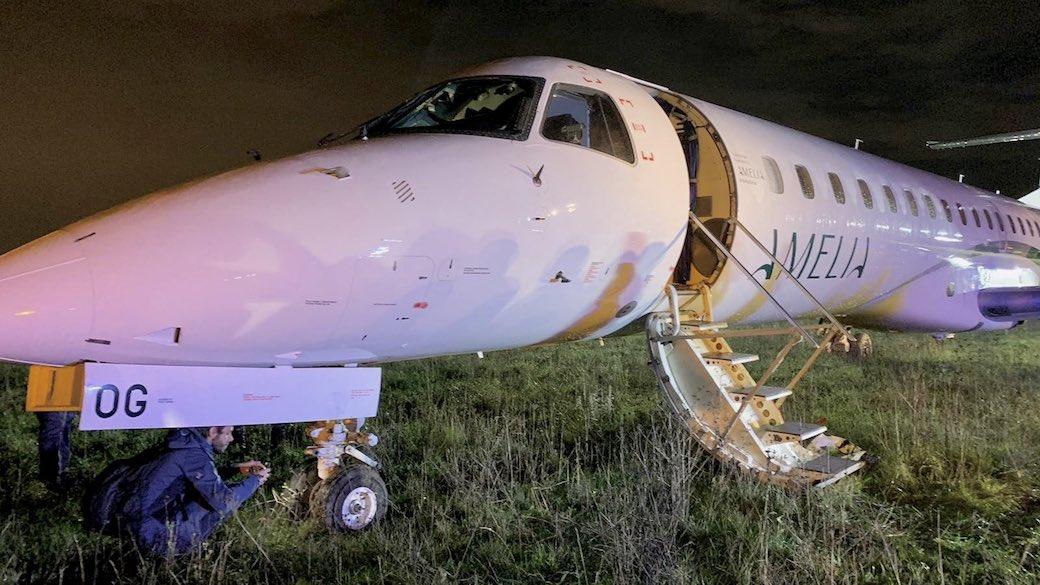BEA: Poor Crew Coordination Caused Amelia ERJ145 Orly Runway Overrun

LYON—A serious incident involving an Amelia International-operated Embraer ERJ145 regional jet in 2022 at Paris Orly Airport was caused by inadequate action by both pilots in challenging weather conditions, says France’s BEA accident investigation bureau.
The poorly coordinated approach and landing resulted in a 1,500-ft. runway overrun, the BEA reports. The aircraft was damaged only slightly, and none of the 39 passengers or three crewmembers (including one flight attendant) were injured. The incident took place on Oct. 20, 2022, some 20-30 min. after sunset and between thunderstorms. The aircraft was flying on a regular route from Rodez in southwest France.
In-production commercial aircraft are now equipped with runway overrun protection systems. This was not the case for Amelia’s ERJ145.
The contributing factors the BEA identified start with the lack of sharing of doubts and concerns, meaning the crew did not have a common plan. Crew collaboration during descent was “disintegrated” and the roles of the pilot flying (PF) and the pilot monitoring (PM—in this instance, the captain) were not distributed as they should have been, investigators say. Moreover, they add that they saw an evolution toward an “autocratic cockpit,” where the captain exceeded the role as a PM and the PF accepted without asserting himself.
The pre-approach briefing factored in the thunderstorm threat, but the crew stopped short of planning mitigation.
During the descent, the crew was unable to agree on a strategy to avoid storm cells. The distribution of roles between the PF and PM, as well as decision-making and situational awareness, gradually deteriorated. The PM took initiatives that effectively ignored requests from the PF. Subsequently, he made control inputs without prior coordination with the PF, according to the BEA. This led to a degradation of the captain’s own ability to effectively act as PM.
Traveling at 60 kt. faster than recommended, the report says the aircraft could not capture the instrument landing system’s vertical plane, which is designed to help the crew with lateral guidance to touchdown.
The BEA further notes the PF quickly rectified the horizontal trajectory, but that correction came to the detriment of the vertical trajectory. The aircraft found itself above the glideslope.
The PM then improvised a procedure to catch the glideslope from above. However, that attempt to return to the nominal descent plane failed. The aircraft eventually made it to the targeted trajectory at an altitude of 1,500 ft.
At that point, the workload had become too heavy for the crew, and they lost situational awareness, the BEA says. The aircraft’s energy was no longer clear to them. They did not hear an alarm about flap configuration.
The pre-landing checklist was not implemented. The PM was no longer in his surveillance function, busy with other tasks related to flight management and change of strategy, the investigators say. The PF was focused on flying in turbulence and rain showers.
The aircraft flew past the runway threshold at 30 kt. faster than the reference speed. Flap extension happened when the aircraft was already in ground-effect and the aerodynamic impact moved the landing point farther. The aircraft’s touchdown took place 3,300 ft. from the threshold.
The crew did not factor in the announced 8 kt. of tailwind, and it unknowingly had to cope with an additional 23 kt., due to fast-changing conditions. Water was contaminating the runway’s surface, so braking was much less effective than expected. The aircraft went past the end of the runway at 80 kt.
The operator conducted an internal investigation, and an immediate measure was recommended: simulator training to assess the pilots’ non-technical skills. Among others, competencies in cooperation and decision-making would have been evaluated, as well as the ability to follow procedures in a heavy workload, the BEA report says. That action was not carried out and the crew was dismissed.
